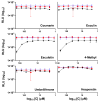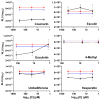Coumarins and Hesperetin Inhibit Human Respiratory Syncytial Virus Infection
- PMID: 39769063
- PMCID: PMC11676883
- DOI: 10.3390/ijms252413301
Coumarins and Hesperetin Inhibit Human Respiratory Syncytial Virus Infection
Abstract
Respiratory syncytial virus (RSV) is one of the most prevalent viruses that causes severe acute lower respiratory tract infections (ALRTIs) in the elderly and young children. There is no specific drug to treat RSV, only a broad-spectrum antiviral, ribavirin, which is only used in critical cases. Our research group is investigating antiviral agents of natural origin, such as coumarins and flavonoids, that may help reduce or prevent RSV infection. The cytotoxic concentrations of coumarins and hesperetin were tested on A549 and HEp-2 cells and used in inhibition tests in which 80% of the cells were viable. The anti-RSV action of the molecules was analyzed in A549 and HEp-2 cells and in HBE cell cultures infected with RSV-luc or rgRSV. We also encapsulated the compounds using β-cyclodextrin to improve the permeability and solubility of the molecules. Esculetin and 4-methyl inhibited rgRSV effectively on A549 and HEp-2 cells after 24 hpi, and when they were encapsulated, coumarin, esculetin, and hesperetin presented inhibition against rgRSV in HBE culture. The coumarins inhibit RSV replication in cell culture and even manage to overcome the mucus barriers of the HBE cultures, and β-cyclodextrin was essential for some of the coumarins to enter the cell and therefore to reach their targets.
Keywords: A549 cells; HBE culture; HEp-2 cells; RSV; coumarins; hesperetin.
Conflict of interest statement
The authors declare no conflicts of interest.
Figures







Similar articles
-
Monoterpene-Containing Substituted Coumarins as Inhibitors of Respiratory Syncytial Virus (RSV) Replication.Molecules. 2021 Dec 10;26(24):7493. doi: 10.3390/molecules26247493. Molecules. 2021. PMID: 34946573 Free PMC article.
-
Multiple Respiratory Syncytial Virus (RSV) Strains Infecting HEp-2 and A549 Cells Reveal Cell Line-Dependent Differences in Resistance to RSV Infection.J Virol. 2022 Apr 13;96(7):e0190421. doi: 10.1128/jvi.01904-21. Epub 2022 Mar 14. J Virol. 2022. PMID: 35285685 Free PMC article.
-
Verdinexor (KPT-335), a Selective Inhibitor of Nuclear Export, Reduces Respiratory Syncytial Virus Replication In Vitro.J Virol. 2019 Feb 5;93(4):e01684-18. doi: 10.1128/JVI.01684-18. Print 2019 Feb 15. J Virol. 2019. PMID: 30541831 Free PMC article.
-
Respiratory syncytial virus entry inhibitors targeting the F protein.Viruses. 2013 Jan 16;5(1):211-25. doi: 10.3390/v5010211. Viruses. 2013. PMID: 23325327 Free PMC article. Review.
-
[Prospects For the Use of Peptides against Respiratory Syncytial Virus].Mol Biol (Mosk). 2019 Jul-Aug;53(4):541-560. doi: 10.1134/S002689841904013X. Mol Biol (Mosk). 2019. PMID: 31397431 Review. Russian.
References
-
- Calışkan M., Bochkov Y.A., Kreiner-Møller E., Bønnelykke K., Stein M.M., Du G., Bisgaard H., Jackson D.J., Gern J.E., Lemanske R.F., Jr., et al. Rhinovirus wheezing illness and genetic risk of childhood-onset asthma. N. Engl. J. Med. 2013;11:1398–1407. doi: 10.1056/NEJMoa1211592. - DOI - PMC - PubMed
MeSH terms
Substances
LinkOut - more resources
Full Text Sources
Medical

